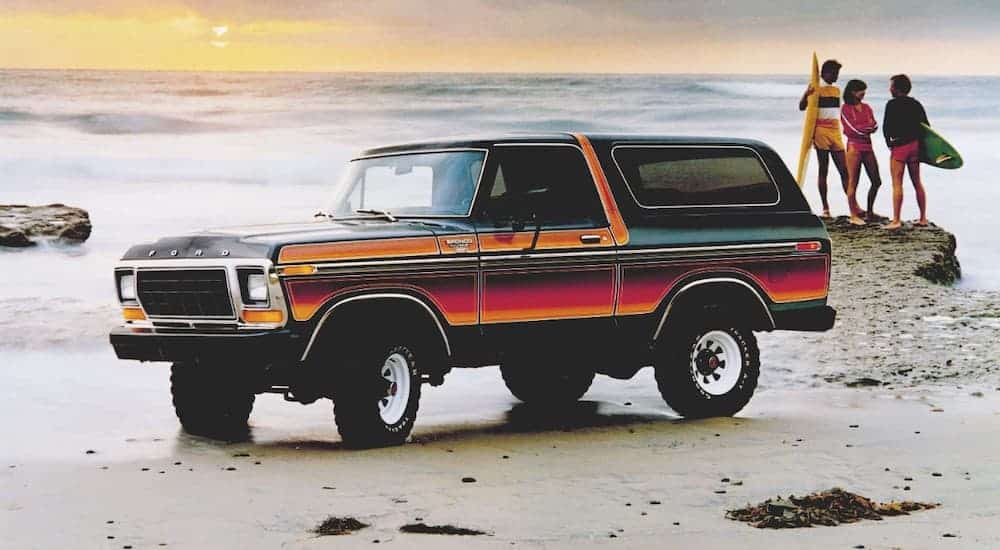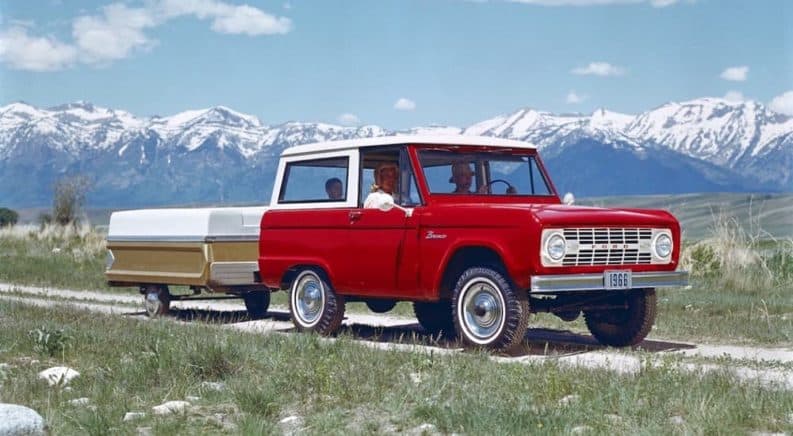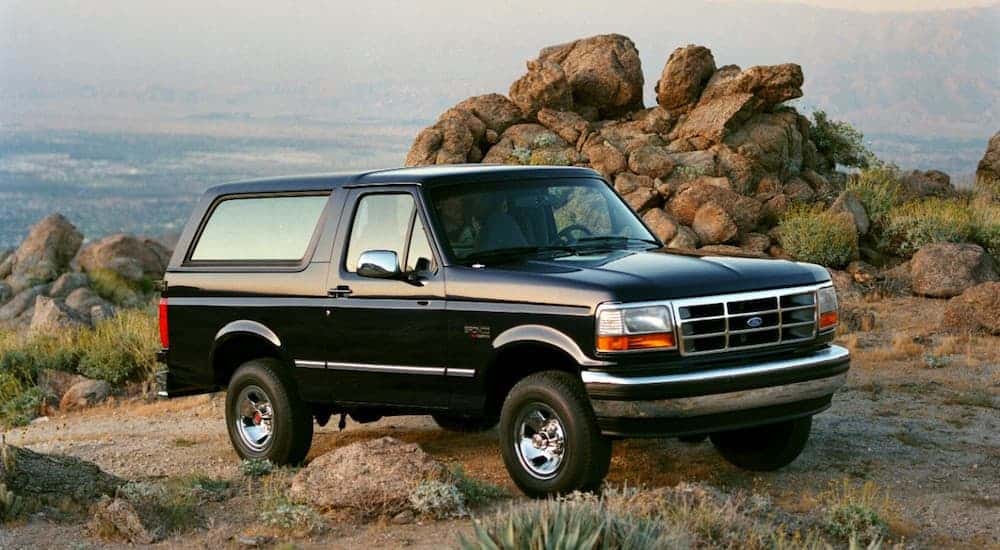Throughout history, certain car models remain beloved, even long after they’ve left the showroom floor. The Volkswagen Bus is an example of these exceedingly classic vehicles. Loved for its iconic design and an incredible range of personalization, VW Buses can still be seen rolling down coastlines across the world, even though the model hasn’t officially been in the Volkswagen lineup for some time now (of course that excludes the last remaining VW bus factory, which shut its doors in 2013). Another iconic vehicle that ended before its prime was the Ford Bronco. First introduced in 1965, the Ford Bronco was a beast of an SUV, that was a tremendous hit for decades. Today, the Ford Bronco is another beloved classic, old models kept in prime condition by utility-vehicle lovers across the globe. While the Ford Bronco was officially discontinued in 1996, this Ford powerhouse is about to make a comeback, and it just might show up in Ford’s 2020 Models lineup.
The Origins of the Ford Bronco
Since its iteration in 1965, the Ford Bronco has always been a full-sized SUV offering a heavy-duty driving experience unlike anything else in its class. The first generation of the Ford Bronco was introduced to the world in 1966 by Ford product manager Donald N. Frey, Ford engineer Paul G. Axelrad, and approval overseer Lee lacocca. The first iteration of the Ford Bronco was marketed to the world as an off-road vehicle, meant to directly compete against the Jeep CJ-5 and the International Harvester Scout. The Ford Bronco entered the market in an upswing trend towards the full-sized SUV and setting the stage for other popular utility vehicles like the Chevrolet Blazer and the Jeep Cherokee.
The first generation of the Ford Bronco ran from 1965 to 1977, and looked far different from anything we can expect from the anticipated 2020 model. All models of the Ford Bronco were sold with four-wheel-drive and equipped with a 170 cubic inch inline-6 engine, which offered up 105 horsepower. This 6-cylinder option was supported by a V8 option in 1966, which offered up 200 horsepower to drivers. The initial design of the Ford Bronco set the groundwork for the stylings of all future models. Some might describe it as boxy. However, this is a box shape that certainly has some charm. Sales were consistent for the Ford Bronco from 1966 to. 1974, however, began to trail off shortly after. So, in 1978, Ford moved onto the second generation of their impressive full-sized off-road capable SUV.

A Classic Is Born
The Ford Bronco truly established itself as a classic with the introduction of the second generation. Designed to compete with the Chevrolet K5 Blazer, the Dodge Ramcharger, and the Jeep Cherokee, the 2nd iteration of the Ford Bronco capitalized on the success of its founding model. At the time, manufacturers were opting for more compact. This was all in response to the 1873 fuel crisis when gas prices skyrocketed to unprecedented levels. Ford bucked the consensus, and expanded the size of the Ford Bronco with the second generation, adding 12 inches of wheelbase, 11 inches of width, 28 inches of length, and 4 inches of height. Unlike the first generation, the second offered only a 3-door option, providing a particularly unique design choice.
This second generation model also offered a lift-off rear hard top, expanding on the Bronco’s degree of customizability. Beneath the hood of the 2nd generation, the Ford Bronco had the 158 horsepower Ford 351M V8 engine which put out an incredible 262 lb-ft worth of torque. While the second generation Ford Bronco only offered one body type, the many stylings, and colors of the SUV earned the vehicle widespread appeal, pushing its popularity and earning approval for a third version.
If it Ain’t Broke
The third generation of the Ford Bronco was introduced to car buyers in 1980. Ford did little to change the SUV’s exterior design sticking to the exclusive 3-door option, and the same hefty sizing that the Ford Bronco had become known for. What truly changed with the Ford Bronco was its interior dressings. The third iteration of the Ford Bronco reintroduced a 6-cylinder engine as standard. Drivers could still opt for a V8 option, however, would have to invest in higher trim options. Speaking of trim options, the Ford Bronco offered three variations the base model, Bronco XL, and Bronco XLT. In 1985, Ford introduced a change up to the Bronco trim family, offering the Eddie Bauer trim package, which included a two-tone styling, and an interior decked out in outdoor-themed trimmings. All that said, Ford took a different direction moving on from the third generation, opting for a more traditional ‘modern-at-the-time look.’
The Fourth and Fifth Generations
While the third generation Ford Bronco is still considered a classic, later iterations would veer away from what had made the Bronco so special. The fourth generation was introduced in 1987 and was given a complete face-lift. While not as charming as previous models, the fourth generation Ford Bronco offered an intuitive push-button four-wheel drive system and stuck with the consistency of the 4.9 inline-6 engine from the third iteration.
The fifth generation of the Ford Bronco hit showroom floors in 1992, and by this time looked far different from the classic models that founded the vehicle. Ford introduced a series of safety improvements with the fifth generation model, including driver-side airbags and reinforced internal door beams. Unfortunately, in 1996, the Ford Bronco was discontinued to provide room for the Ford Expedition, its much more modern counterpart. While the Ford Bronco was still a success at the time, it didn’t compete as well against rival vehicles like the Chevrolet Tahoe, GMC Yukon, and Chevrolet Suburban.
The Rebirth of a Classic
Come 2020, the Ford model lineup can expect a fresh, yet familiar face, the 2020 Ford Bronco. There is still little known about the triumphant return of the Bronco. However, experts speculate it will house an EcoBoost engine, which was quite successful in the off-roading pickup, the Ford F-150 Raptor. We can expect for the horsepower delivery to existing somewhere over the 325 hp range and offer a considerable amount of forward torque. In terms of styling, there is still a lot to uncover. We do know that Ford will first unveil a smaller version of the newest Bronco, which will be directly inspired from the 2020 model Ford Escape. There is speculation that we won’t see a full-sized Ford Bronco until sometime after 2021.
The 2020 re-release of the Ford Bronco model can be expected to return to the roots of what made the original Ford Bronco such a success. Like other off-road competitors, the newest Ford Bronco is expected to sport a 4×4 drivetrain and be built for taking on the roughest of trails. While we aren’t likely to see the classic ‘two-door’ design in the full-sized Ford Bronco, it will be built on a frame similar to the Ford Ranger.
While there is a lot to expect and hope for with the 2020 Ford Bronco, it is difficult to separate this latest iteration from its early beginnings. First as a challenger to other full-sized SUVs, then phased out due to the growing ‘compact trend,’ the modern Ford Bronco will enter a widely competitive field where the SUV is king yet again. Needless to say, we’re excited to see what Ford will offer in this classic reintroduction.





